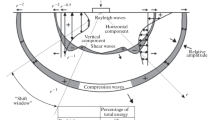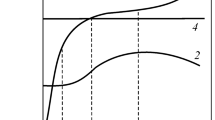Abstract
Brittle material behavior and mode of failure are contrasted with those characteristics of ductile materials. The stochastic nature of brittle fracture, which results from the random occurrence of fracture-initiating microstructural imperfections, necessitates a probabilistic fracture mechanics approach to design with brittle materials. It is also clearly shown which main properties of brittle materials have to be optimized to improve the reliability of mechanically loaded components made of brittle materials. Important features of designing with brittle materials are elucidated and illustrated by an exemplary design calculation of a ceramic disc spring. It is shown how even environmentally induced subcritical crack growth, characteristic of ceramic materials, can be adequately accounted for in the assessment of reliability.
Similar content being viewed by others
References
G.D. Quinn: “Strength and Proof Testing” in Engineered Materials Handbook, Vol. 4: Ceramics and Glasses, S.J. Schneider, ed., ASM International, Materials Park, OH, 1991, pp. 585–98.
J.B. Wachtman: Mechanical Properties of Ceramics, John Wiley & Sons, New York, NY, 1996.
R.O. Ritchie and R.H. Dauskardt: “Fracture in Ceramics, Cyclic” in The Encyclopedia of Advanced Materials, D. Bloor et al., ed., Elsevier Science, Oxford, UK, 1994, pp. 791–98.
C. Gandhi and M.F. Ashby: “Fracture-Mechanism Maps for Materials Which Cleave: F.C.C., B.C.C. and H.C.P. Metals and Ceramics,” Acta Metall., 1979, 27, pp. 1565–1602.
R. Danzer: “Subcritical Crack Growth in Ceramics,” in The Encyclopedia of Advanced Materials, D. Bloor et al., ed., Elsevier Science, Oxford, UK, 1994, pp. 2693–98.
J.E. Ritter: “Crack Propagation in Ceramics” in Engineered Materials Handbook, Vol. 4: Ceramics and Glasses, S.J. Schneider, ed., ASM International, Materials Park, OH, 1991, pp. 694–99.
S.M. Wiederhorn, “Subcritical Crack Growth in Ceramics” in Encyclopedia of Materials Science and Engineering, M.B. Bever, ed., Pergamon Press, Oxford, UK, 1986, pp. 4714–20.
R. Danzer: “A General Strength Distribution Function for Brittle Materials,” J. Eur. Ceram. Soc., 1992, 10, pp. 461–72.
W. Weibull: “A Statistical Theory of the Strength of Materials,” Ingeniörsvetenskapsakademiens Handlingar, Nr. 151, Stockholm, Sweden, 1939.
W. Weibull: “A Statistical Distribution Function of Wide Applicability,” J. Appl. Mech., 1951, 18, pp. 293–97.
A.M. Freudenthal: “Statistical Approach to Brittle Fracture” in Fracture: An Advanced Treatise, Vol. II: Mathematical Fundamentals, H. Liebowitz, ed., Academic Press, New York, NY, 1968, pp. 591–619.
W.E.C. Creyke, I.E.J. Sainsbury, and R. Morrell: Design with Non-Ductile Materials, Applied Science Publishers, Barking, UK, 1982.
S.B. Batdorf: “Fracture: Statistical Theories” in Encyclopedia of Materials Science and Engineering, M.B. Bever, ed., Pergamon Press, Oxford, UK, 1986, pp. 1858–64.
T. Thiemeier: “Lebensdauervorhersage für keramische Bauteile unter mehrachsiger Beanspruchung,” Ph.D. Thesis, Universität Karlsruhe, Fakultät für Maschinenbau, 1989 (in German).
S. Krüger: “Ein Beitrag zur praxisgerechten Dimensionierung keramischer Bauteile bei mehrachsigen Beanspruchungen,” Ph.D. Thesis, Technische Universität Clausthal, 1999 (in German).
R. Morrell: Handbook of Properties of Technical & Engineering Ceramics, Part 1: An Introduction for the Engineer and Designer, Her Majesty’s Stationery Office, London, 1989.
Y. Hamano: “Progress in Structural Applications of Silicon Nitride” in Silicon-Based Structural Ceramics, B.W. Sheldon and S.C. Danforth, ed., American Ceramic Society, Westerville, OH, 1994, pp. 3–14.
K.D. Mörgenthaler: “Ceramic Valves-A Challenge?” in Ceramic Materials and Components for Engines, K. Niihara et al., ed., Japan Fine Ceramic Association, Tokyo, 1998, pp. 46–51.
M.J. Hoffmann and G. Petzow, ed.: Tailoring of Mechanical Properties of Si 3N4 Ceramics, Kluwer Academic Publishers, Dordrect, Holland, 1994.
H. Hempel and H. Wiest: “Structural Analysis and Life Prediction for Ceramic Gas Turbine Components for the Mercedes-Benz Research Car 2000,” ASME Paper No. 86-GT-199, ASME International, 1986.
G.D. Quinn and J.B. Quinn: “Slow Crack Growth in Hot-Pressed Silicon Nitride” in Fracture Mechanics of Ceramics, A.G. Evans et al., ed., Plenum Press, New York/London, 1993, pp. 603–36.
G.D. Quinn and R. Gettings: “Standard Reference Material 2001: Ceramic Fracture Toughness,” Ceram. Eng. Sci. Proc., 20, 1999, pp. 513–23.
S.R. Choi, L.M. Powers, F.A. Holland, and J.P. Gyekenyesi: “Creep of Silicon Nitride Under Various Specimen/Loading Configurations” in Ceramic Materials and Components for Engines, J.G. Heinrich and F. Aldinger, ed., Wiley-VCH, Weinheim, Germany, 2001, pp. 291–98.
R. Morrell: Handbook of Properties of Technical & Engineering Ceramics, Part 2: DataReviews, Sect. 1: High Aluminia Ceramics, Her Majesty’s Stationery Office, London, UK, 1987.
M. Matsui: “The Reliability Evaluation of Structural Ceramics,” FC Annual Report for Overseas Readers, Vol. 20, Japan Fine Ceramics Assoc., Tokyo, Japan, 1989, pp. 20–26.
T. Lube and R. Danzer: “An ESIS Testing Program for a Silicon Nitride Reference Material” in Fracture Mechanics Beyond 2000, K. Golos, D. Kocanda, and A. Neimitz, ed., Engineering Materials Advisory Service, Sheffield, UK, 2002, pp. 401–08.
T. Lube, R. Danzer, J. Dusza, and J. Kübler: “Strength and Fracture Toughness of the ESIS Silicon Nitride Reference Material” in Fracture Mechanics Beyond 2000, K. Golos, D. Kocanda, and A. Neimitz, ed., Engineering Materials Advisory Service, Sheffield, UK, 2002, pp. 409–16.
G. Roeben, J.-P. Erauw, T. Lube, R.G. Duan, F. Cambier, and O. van der Biest: “Microstructure Characteristics Related to the High Temperature Fracture Resistance of the ESIS Silicon Nitride Reference Material” in Fracture Mechanics Beyond 2000, K. Golos, D. Kocanda, and A. Neimitz, ed., Engineering Materials Advisory Service, Sheffield, UK, 2002, pp. 77–84.
T. Hirano, K. Niihara, and T. Ohji: “Effects of Matrix Grain Size on the Mechanical Properties of Si3N4/SiC Nanocomposites Densified With Y2O3,” Mater. Lett., 1996, 27(1–2), pp. 53–68.
W. Hübner: “Deformationen und Spannungen bei Tellerfedern,” Konstruktion, 1982, 34, pp. 387–92 (in German).
F. Dubois: “Über die Festigkeit der Kegelschale,” Ph.D. Thesis, ETH Zürich, Switzerland, 1917 (in German).
R.W. Davidge: Mechanical Behaviour of Ceramics, Cambridge University Press, Cambridge, UK, 1979.
Author information
Authors and Affiliations
Rights and permissions
About this article
Cite this article
Rubeša, D., Smoljan, B. & Danzer, R. Main features of designing with brittle materials. J. of Materi Eng and Perform 12, 220–228 (2003). https://doi.org/10.1361/105994903770343385
Received:
Revised:
Published:
Issue Date:
DOI: https://doi.org/10.1361/105994903770343385




